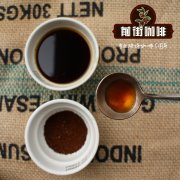Know how coffee beans come from. How do stir-fried coffee beans taste?

Professional coffee knowledge exchange more coffee bean information please follow the coffee workshop (Wechat official account cafe_style)
Roasted, ground and brewed coffee beans are actually the seeds of coffee fruit. Like all plants in nature, coffee fruit comes from coffee trees, which grow through a single seed.
Different varieties of coffee, the shape and characteristics of coffee such as the color and shape of leaves, as well as the adaptability of the tree itself to the external environment (resistance to diseases and insect pests, temperature … ) there will be differences, and eventually the characteristics of the seeds will be different.
If a coffee tree is allowed to grow naturally in the wild, it may eventually be more than 10 meters. In modern production, in order to facilitate picking and harvest, farmers will constantly prune and cut off the coffee, which is not only more convenient to operate, but also can make the nutrient content of each coffee tree per unit area sufficient to meet the needs of leaves and fruits on the whole tree, thus making the quality better and more stable.
After the coffee seed is planted in the nursery, it takes about 90 days to nursery before it can be transplanted to the field. Normally, it takes 3-5 years from the seed to the first hanging fruit. In most cases, each coffee tree can produce about 6-10 kg of fresh fruit in each season, which translates to about 1-1.5 kg of raw beans and about 1 kg of roasted beans. The output of coffee is lower than can be seen.
The coffee fruit has many layers from the inside to the outside, and the outermost layer is the coffee peel.
Depending on the variety, the color of the coffee pericarp changes from green at the beginning to crimson, yellow, orange, or even pink during maturity. In order to improve the quality of coffee, picking coffee needs to selectively pick the fruit of the best ripening period, and the color of the pericarp is one of the physical characteristics to distinguish the ripening period of different varieties of coffee.
The underlying tissue of the skin is coffee pulp, and the inner layer of the pulp is a layer of honey-like coffee mucus, also known as the pectin layer. Pulp and pectin contain a lot of sugar and authigenic microorganisms, coffee treatment is mainly the use of coffee pulp and pectin microorganisms and sugar to produce fermentation, so as to create a very delicious flavor.
Inside the pectin layer is a layer of "parchment paper" with high hardness, and then inside is the coffee seed wrapped in silver skin. Coffee belongs to dicotyledons, and a coffee fruit often contains two seeds.
Parchment layer and silver skin are protective layers of coffee. When coffee beans are dried to a standard moisture content, parchment will be peeled off by machine during dry processing, and most of the parchment will fall off during baking, leaving only coffee beans.
The flavor composition of the coffee beans we have just baked has been basically confirmed. Many people blame the coffee beans for their deterioration. In fact, all foods or things change slightly after oxidation, affecting the taste. The change in the taste of coffee is particularly obvious in time. The coffee beans we have just baked release a large amount of aroma factors and carbon dioxide, which are released through small holes through the roasted coffee beans, which are released by grinding. In the process of brewing, the coffee powder will be blocked from contact with water, resulting in insufficient flavor extraction, and as time goes on, the atmosphere of carbon dioxide becomes thinner and less, and the contact area increases. Coffee is also becoming more and more flavorful, so many people do not call raising beans as raising beans, but a process of venting and venting.
The so-called coffee beans, in fact, when we roast the coffee beans after a precipitation is stable, when the coffee is roasted, the coffee beans will release a large amount of nitrogen dioxide.
Coffee beans are like living people. People oxidize their cells with oxygen inhalation, which is also a process of aging. The freshly roasted coffee is too young to reach the most mature stage, just like human beings. It takes years to grow up to make you more mature, and it takes some time for coffee beans to grow. Let it reach the peak of flavor, and then slowly disappear.
END
Important Notice :
前街咖啡 FrontStreet Coffee has moved to new addredd:
FrontStreet Coffee Address: 315,Donghua East Road,GuangZhou
Tel:020 38364473
- Prev

How coffee beans are made into various flavors | how is coffee bean flavor formed?
Professional coffee knowledge exchange more coffee bean information please pay attention to coffee workshop (Wechat official account cafe_style) coffee beans, is the core of the fruit of the coffee tree, in short, it is the seed of coffee. It contains a lot of nutrients, in which sugar plays a key role in the taste of coffee, and the higher the altitude, the higher the sugar content. Coffee roasting is a rush.
- Next

Which is cost-effective, coffee beans or coffee powder? do you grind the coffee beans yourself or buy the powder directly?
For more information on coffee beans, please follow the coffee workshop (Wechat official account cafe_style) first of all, coffee beans. We all know that to turn roasted coffee beans into a cup of coffee requires grinding, boiling water, weighing, brewing and other processes. At the same time, each step needs to be implemented with different tools, a relatively complex process and the tools that need to be equipped.
Related
- Beginners will see the "Coffee pull flower" guide!
- What is the difference between ice blog purified milk and ordinary milk coffee?
- Why is the Philippines the largest producer of crops in Liberia?
- For coffee extraction, should the fine powder be retained?
- How does extracted espresso fill pressed powder? How much strength does it take to press the powder?
- How to make jasmine cold extract coffee? Is the jasmine + latte good?
- Will this little toy really make the coffee taste better? How does Lily Drip affect coffee extraction?
- Will the action of slapping the filter cup also affect coffee extraction?
- What's the difference between powder-to-water ratio and powder-to-liquid ratio?
- What is the Ethiopian local species? What does it have to do with Heirloom native species?

